How much is a $60k Mustang worth?
Every cent – plus change.
That’s not quite what it costs to buy a new Mach 1 – if you don’t opt for everything – but even if you do, it’d be worth the spend.
Because of the drive.
What It Is
The Mach 1 is a functionally and visually amped-up version of the Mustang GT, the iconic muscle car Ford has been building since 1964. It comes with everything the regular GT has – including the 5.0 liter V8 – but with its output kicked up to 480 horsepower – along with a bellowing four-pipe-tipped exhaust system, vise-grip Brembo brakes tucked inside 19-inch light allow wheels, track-ready suspension and exterior/interior visuals to match. 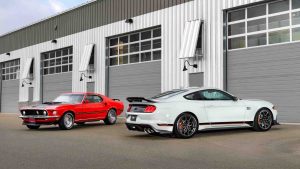
Plus some parts picked from the discontinued GT350 and the still-available but much more spendy (and automatic-only) GT500.
The Mach1 stickers for $51,720 – a $15,600 bump up over the asking price of a base Mustang GT, which is itself a helluva car and worth every cent of that, too.
But some things are worth more, even if you can put a price on them.
What’s New
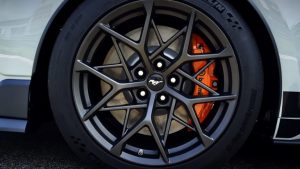 The Mach 1 replaces the Bullitt GT as the maximum Mustang . . . or at least, the most maximum Mustang you can still get with a manual transmission now that the $59,150 GT350 is off the roster.
The Mach 1 replaces the Bullitt GT as the maximum Mustang . . . or at least, the most maximum Mustang you can still get with a manual transmission now that the $59,150 GT350 is off the roster.
What’s Good
Memories of 1968 – and 2020.
The power – and the clutch.
Finesse that’s lacking in rivals like Challenger; practicality that’s absent in rivals like Camaro.
What’s Not So Good
2021 price tag – plus tax.
Small (16 gallon) fuel tank makes for short hops in between stops.
Backseat legroom isn’t terrible for the type of car it is, but headroom is – the price you pay for that sexy swept-back roofline.
In 1968 – when the first Mach 1 was announced – the strongest engine it could be ordered with was the Super Cobra Jet 428 (7 liters) and it made 335 advertised horsepower. In 2021, the Mustang’s standard 2.3 liter “Ecoboost” turbocharged four cylinder engine makes 310 horsepower.
It takes more to impress, 50 years hence.
Enter today’s Mach 1.
It comes standard with a comparatively small 5.0 liter V8, both in terms of history and modernity. Current rivals like the Dodge Challenger and Chevy Camaro both come standard with bigger V8s (5.7 liters and 6.2 liters, respectively).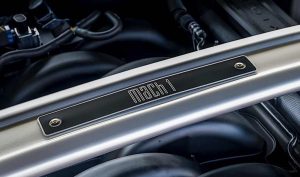
Interestingly, the Ford’s smaller V8 makes more horsepower per liter – 480 in the Mach 1 (up from 460 in the base GT) vs. 375 in the base Challenger R/T (485 if you opt for the Challenger’s even larger 6.4 liter V8) and 455 in the Camaro SS – which doesn’t offer an upgrade unless you opt for the $74,200 ZL1, which is comparable to the $70,300 Mustang GT500 and not really a fair cross-shop vs. the $51,720 Mach 1.
The reason for that being airflow.
The Ford 5.0 is – uniquely, among modern muscle cars – a dual overhead cam V8, with four valves per cylinder rather than two as in the rival V8s. Combine this power with the Mustang’s fairly light weight of 3,705 lbs. (as opposed to the beefy Challenger’s 4,182 lbs.) and what you end up with is more output-per-displacement and 0-60 in about 4 seconds – which for the record is about 2 seconds quicker than a first-year Mach 1 with the 7.0 liter Super Cobra Jet 428 V8. 
Which was about as quick as a brand-new Mustang with the 2.3 liter EcoBoosted four cylinder engine.
Times are good! Literally as well as actually.
What accounts for the Mach 1’s 20 additional horsepower vs. the GT’s iteration of the 5.0 V8? A few old school tweaks with modern twists. The first being a larger (85 mm) throttle body, which is essentially the same thing as swapping in a larger CFM carburetor, back in the day – the idea in both cases being to get more air into the engine. There is also an open-element air cleaner – this time conical rather than old-school circular and without the chrome air cleaner lid, as back in the day. Which is the one aesthetic thing that the old CJ 428 and muscle car engines of the classic era had – and still have – over the new stuff:
They all looked better, when you popped the hood – even if they didn’t breath better, with it closed.
There is also an old school hot rod trick reimagined with electronics. The Mach 1 has an “active” exhaust, which means that at the touch of a button, a kind of wastegate is opened that bypasses the usual muffling, to increase the power and the sound – which is a huge part of what a car like this is all about.
More about that below.
But the biggest point of departure isn’t what’s under the Mach 1’s matte black racing-striped hood but what’s behind its tuned-up engine. It’s the same heavier-duty (and many say, much-better-shifting) Tremec TR 3160 six speed manual that was used in the street-legal-race-car GT350 – and which you cannot get in the regular GT. You’ll also get the GT500’s rear differential cooler and you can order the GT 500’s Gurney Flap – a rear spoiler named after the famous race car driver.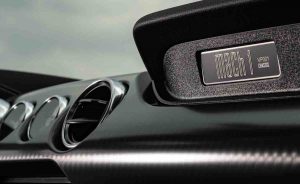
And if you want it, there is also a ten speed automatic transmission, a $1,595 option. This was not offered with the GT350, which was manual-only.
There’s one other thing you get as well. A top speed that’s higher than 115 MPH – which was the top speed of a ’69 Mach 1 428 Cobra Jet. Which is about the top speed of a new Prius hybrid – given enough time.
Not because the original Mach 1 was under-engined. It was under-geared. In the classic muscle days, you had three or four gears and not one of them was an overdrive. That meant you were mechanically limited by the gearing to a top speed that’s embarrassingly slow by today’s standards.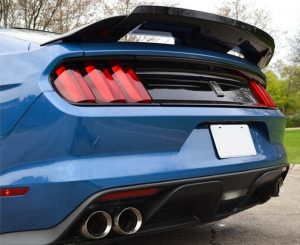
A modern muscle car like this Mach 1 will do 115 in third gear. It has three more to go. So it goes considerably faster than a Prius, without needing much room to do it.
It also gets astoundingly good gas mileage given that it has almost four times as much power as a Prius: 15 city, 24 highway – which is not far off the pace of something like a new family-hauling minivan like the Kia Carnival I wrote about recently. It gets 19 city, 26 highway and even though it does have overdrive gearing it does not go as fast as the Mach 1.
The Mach 1 seems much thirstier than it is because of its comparatively small (16 gallon) gas tank. Driven as you should and will, this may take you about 230 miles down the road. That’s about how far it took me, at any rate. Even my ’76 Trans-Am does better than that – and it has a 7.5 liter (455 cubic inch) V8.
But it also has a 21.5 gallon tank.
On The Road
You have no doubt heard of hybrid vigor. The Mach 1 is very . . . vigorous. It blends the everyday-driverness of the regular Mustang GT with the additional pep in its step of the GT350, which was not an everydriver driver due to the race-track-intended 5.2 liter flat-plane crank’d V8 that spins to 8,250 RPM and makes its peak 526 horsepower at 7,500 RPM – an engine speed that’s hard to achieve in between red lights, on the street.
Or even in third gear – without driving the thing like you would on the track, which is dicey on the street . . . if you wish to avoid sitting in jail.
The Mach is milder-mannered, but capable of being less so when the occasion arises and the polizei aren’t around to witness it. All 480 horse are accessible at a more reachable 7,000 RPM and there is plenty of power below that speed.
Also, the GT350 was manual-only, precisely because its engine was born to rev and manuals are the better tool for that. The Mach gives you the option to go automatic and without sacrificing snap.
Or the fry.
Turn the traction control off – please – using the toggle switch ahead of the shifter. Put the box in S rather than D. Now hold the rear tires by holding the brake pedal down and feed some throttle until they begin to slip and smoke. Ease off the brakes just a touch as you floor the gas and let ‘er rip. Tactical atomic blasts mark your passage, scorched earth stripes for 50 yards behind the perimeter of the mushroom cloud you just left.
But be careful. This car is not a toy for the inexperienced or the stupid. With the TC off, it can get away from you because there is almost 500 horsepower feeding the rear wheels and no stubble-chinned Soy Boy electronica to save you, if you had the nerve to turn it off and don’t have the skills to deal with it.
There are a variety of driver-selectable programs, of course – including Track and Launch Control. But Ford has left it up to you to decide your level of engagement, assuming – for once – that you aren’t an idiot and can handle it. 2021 it may be but this car can be toggle-switch back’d to ’69 if you want to – if you are able up to it. If you are not, the car will discipline you.
Respect it.
The sounds made by this car will take you back to ’69 – when radios sucked but who needed them when the car made the right music. Today, audio systems are superb – including the Bang and Olufsen unit that comes in this one. But turning it on is a kind of crime, almost like putting ketchup on a wagyu ribeye. It is nothing less than miraculous that the engineers who design modern muscle cars like this have made them sound like – or even better than – classic muscle cars in spite of the handicaps of multiple catalytic converters and federal “drive by” noise ukase, which eventually silenced the song of the classic muscle cars.
Push the toggle for Sport or higher and the Mach 1’s exhaust opens up like you pulled a cable to bypass the mufflers, as back in the day. With the manual, you can make it sing like a 289 Hi-Po, with a lot mo’ Po. I am a (real, classic) Pontiac guy but concede that Ford has always made some of the best-sounding V8s, going all the way back to the Model A’s flathead mill and through the 289 Hi Po of the ’60s and the 5.0 HO of the ’80s all the way to now.
Yes, the GT350’s flat-plan-crank’d V8 sounds better, like Satan’s bagpipes – but this one will raise the hair, too. And it also has the comforting low-RPM burble that soothes the soul more deeply than any heated or massaging seat ever will – and which no electric car will ever approach.
At The Curb
The Mustang – and not just the Mach 1 – is a very different expression of the muscle car concept relative to the other two muscle cars extant, Camaro and Challenger.
The Challenger is, arguably, the truest expression of the classic muscle car idea. All of the original, classic-era muscle cars were big cars. And so is the current Challenger. It is a much bigger – and much heavier – car than either the Mustang or the Camaro, extending to 197.9 inches end to to end, which is about the same length as a full-size sedan. Which isn’t surprising given it is one – with two doors shaved off.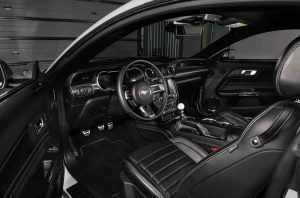
The Dodge is a two-door version of the Charger sedan. Which is why it is has the backseat and trunk room (16.2 cubic feet) of a full-sized sedan. The Camaro and Mustang do not – but the Mustang doesn’t have as little of it as the Camaro, which only has 9.1 cubic feet of trunk, which is less room for whatever you need to carry along with you (other than yourself) than the two-seater Corvette has.
The Mustang’s 13.5 cubic foot trunk is actually about as much trunk as in many current mid-sized sedans and makes this car much more feasible for everyday use than Camaro, without being as massive a car as the Challenger is. Not that there is anything wrong with massiveness.
But it is a clear point of difference.
The Mustang’s backseats would be more passenger-friendly if it weren’t for the duck-and-cover headroom – or rather, its lack. Just 34 inches – as opposed to 37.1 in the Challenger. But the Camaro’s only got 33.5 inches and it feels like less because of the proportions; the Camaro’s roofline relative to its door height and the slit-height of its door glass. Granted this is subjective but I feel like the driver of a tank when inside a Camaro. The Mustang feels more spacious than it is because of its lower door height relative to its roofline and the more abundant glass all around you.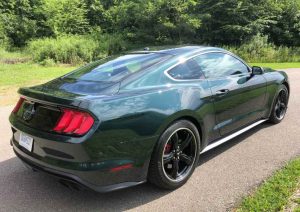
The Mach 1 is also a kind of counterpoint to the retired Bullitt GT, which was all about not looking like what it was capable of. It was shorn of the usual exterior braggadocio – snorky scoops and wings, incandescent paint jobs and accent striping. A Highland Green Bullitt GT could be mistaken for a plain jane base four cylinder Mustang and that was just the point.
There is no mistaking the Mach 1, which is loud and proud, functionally and aesthetically. It has molded into the hood scoops on either side of the matte black billboard strip down the centerline of the hood; Mach 1 badges on the flanks and tail. Most of all, the GT350-ish front clip with the huge and very functional oil/transmission cooler intakes on either side of the protruding chin spoiler (watch those curb dips). Plus the Gurney Flap on the tail.
And, capping it off – if you stick with the stick – the white cue-ball shifter that feels as right in your hand as it looks in between the seats.
Is $51k-plus a preposterous sum to pay for a Mustang? Ask the man who owns a ‘69 Mach 1 429 Cobra Jet Mustang today. If he wanted to – and what fool would want to – he could sell that ’69 and be able to buy two ’21s, today – plus gas money.
How much will a ’21 Mach 1 buy 50 years hence?
I was a fool, in the rearview, to not have bought the ’95 Cobra R I could have bought back in the day, when Ford offered me the chance. Look up the price of a ’95 Cobra R today.
Tomorrow, a car like the Mach 1 might be worth its curb weight in gold and not just because of the historic value of a car such as this. We have likely reached the apogee of the latter-day muscle car; and we may not ever see another apogee. As in the early ’70s, forces are arrayed against cars like this and this time, it may not be possible to overcome them with engineering.
The Bottom Line
They say speed is just a question of money – as in how fast do you want to go? But there are some things that transcend money.
The Mach 1 is one of them.
Gather ye horsepower, while ye may.
. . .
Got a question about cars, Libertarian politics – or anything else? Click on the “ask Eric” link and send ’em in!
If you like what you’ve found here please consider supporting EPautos.
We depend on you to keep the wheels turning!
Our donate button is here.
If you prefer not to use PayPal, our mailing address is:
EPautos
721 Hummingbird Lane SE
Copper Hill, VA 24079
PS: Get an EPautos magnet or sticker or coaster in return for a $20 or more one-time donation or a $10 or more monthly recurring donation. (Please be sure to tell us you want a magnet or sticker or coaster – and also, provide an address, so we know where to mail the thing!)
My eBook about car buying (new and used) is also available for your favorite price – free! Click here. If that fails, email me at [email protected] and I will send you a copy directly!


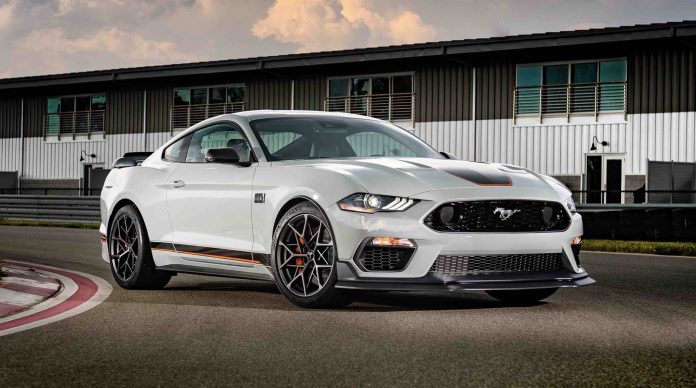

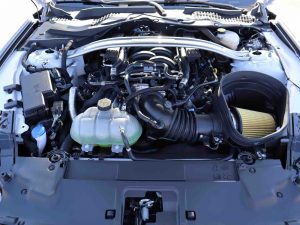

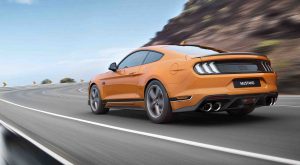









Eric,
Just wondering on this car – what do you recommend, the normal heated / cooled / electric seats, or the optional recaro race seats (loose the electric adjustability and heated/cooled seats). Personally, id probably go for Recaro but want to try first (had standard seats on my old one and they were quite nice), but no Ford dealers have a demo mustang here! I guess my main priority is to be able to sell it quick should I need, any thoughts / recommendations ?
Problem is most dealers here are sold out of these cars, and it seems only a couple can get an order in (9 months to 1 year delivery time!) So trying to get an order in the next few days…. lets see…
Hi Nasir,
This is a purely subjective consideration in my view – as regards the heated/cooled seats vs. Recaro. I would go with the Recaros myself because I like the extra support and the feel of them. But some may prefer to have heaters/coolers and find the other seats more comfortable. I recommend trying both and then deciding based on what suits you!
Eric, with regards to valuation I have a question – do you think these cars will depreciate much ? I got rid of the Mustang GT in Feb- its gone up around 4k since then (in UK money) which is around 13%. Not sure if its because of the season, the shutdowns, or that the car is just going up. The Bullet mustang here has also gone up in value it seems during the last 2 years (though not sure if thats because not many have come off lease yet). What do you think – these cars will depreciate initially, or will just go up?
Hi Nasir,
I think it’s a good bet that any traditional car like the Mustang will increase in value precisely because such cars are becoming less available and may soon be unavailable, new. This assumes, of course, that the world doesn’t end – but in that case, none of this matters, regardless!
Its crazy looking online, the first Mach 1s due to go on sale in the UK are selling for about 80K gbp, even though they are about 55K gbp if you book one.
Im wondering, maybe I should just book one, and well sell it. In Pakistan back in the day when there was a shortage of cars, a bunch of friends of mine who’s parents had a ton of cash made a gig out of booking new cars (for a small deposit) and selling them on the day they arrived….. given the western world is going the same way, perhaps this is a way to make a couple quid on the side?
Wow, a new car that actually might put a smile on my face. It’s the rare review like this one that reminds me what a great job you have!
Looking forward to reading your take on the Hellcat.
You didn’t include the surcharge for these dealer reward specials. Probably $10K.
Give it time. The surcharges end after the early adopters with too much money buy theirs. I really liked the idea of the Focus RS and when it came out, I checked out many dealers, and they were all asking for $5k-$20k over sticker initially. I eventually bought one a year later for sticker price. You won’t get a great deal on a desirable car, however, so sticker is good enough.
Dealers overplayed their hand on the Focus RS markups. Had I waited a few months more, I’d definitely have gotten one more easily. There were dozens of marked up cars sitting on dealer lots, not selling.
I wonder whether I could wrangle an “a plan” deal for a reader here….
This was damn good, – HA! THIS SONG MAY BE IN MY HEAD FOR THE REST OF MY LIFE – have you heard this remix? I imagine it would be good tunes while doing burnouts or sumthin’?:
I DON’T NEED NO VACCINATION!
https://www.lewrockwell.com/political-theatre/i-dont-need-no-vaccination/
Excelent.:)
It would be great to see a similar parody set to “Another Brick in the Wall.”
We don’t need no vaccination
We don’t need no thought control
Hey! Doctors! Leave us folks alone.
All in all, it’s just a…nother brick in the wall…
Of tyranny, that is.
Huh. I just spent a few moments trying to look up the lyrics for that song, for some reason, they all don’t include the telephone operators at the end.
“He hung up… I don’t understand” or some such.
“He slammed the door shut on us [Strike Force Team] I don’t understand” … Beep. Beep.
oh wait. Maybe that’s a different song. I don’t listen to the radio much these days. Still, …
We don’t need no vaccinations
We don’t need no thought control
No forced injections in the darkness
Bearing toxic mystery payloads
Hey! Doctors! Leave us folks alone.
All in all, it’s just a…nother brick in the wall…
Nice car, and great write-up! Kind of surprised after reading your take on the abysmal E-version, didn’t think Ford had it in them any longer. I’m wondering how much obligatory ‘safety-nanny’ tech this car comes with though.
Looking forward to the Hellcat review, especially the ‘blowing off prionics’ video.
Nice scribbling sir. Always a nice read when you’re in your element.
RE: Tank-like drive. I remember driving my cousin’s boyfriend’s Challenger way back when (first year of the Hellcat IIRC), and having a lot of trouble backing out of the driveway because I couldn’t see anything. It was very claustrophobic. I think it was the first time driving a vehicle with a rear back-up camera too, which would have helped had I been trained to use it. I think it might be to save weight, since glass can get heavy, especially when using large panes, which need to be stronger to stand up to abuse. I know I go though more windshields than I did way back when, although that could also be a Rocky Mountain thing.
Eric,
I do enjoy how you love blowing the doors off of the “prionic driver” in your video. It’s the little things, you know?
Indeed!
I freaking love this car. But – wait – it gets better. Guess what is coming tomorrow?
Ummmm… You race a “Mach-E”, which promptly explodes into a brilliant lithium inferno, and you do donuts around the automotive conflagration in victorious celebration??!
Even better!
The Hellcat Redeye arrives tomorrow….
Hey Eric,
Is it available with a manual transmission?
Cheers,
Jeremy
Hi Jeremy,
It is! The Tremec from the GT350, which is no longer made. It’s my next favorite manual… after the Super T10!
Hey Eric,
In the Hellcat?
Holy Jesus… Just a look at the specs on that… It seems almost impossible that they sell cars like this, stock.
Would they get angry with you if you filmed a spinning burnout? More vicarious living for your fans? You’re having a much better summer than I am. 😉
Also, you’re reviewing the last of the V8 interceptors, I’m pretty sure.
Great car. Glad Ford is doing it. Nice job Ford. And nice review Eric, explained everything I need to know, except me actually driving one.
If/when I can afford a play car, it will be this or the Charger/Challenger.
I lean toward the Challenger cause it’s bigger, and the Charger cause it has 4-doors. The Charger Scat Pack in particular has awesome power, then offers the advantage of being able to use it more, like picking up people at the airport, etc…
‘We have likely reached the apogee of the latter-day muscle car; and we may not ever see another apogee.’ — EP
Nope. Looks like the classic muscle car is running out of gas — literally.
So this is the Mustang Mach 1. Whereas another 4-door, electrically-propelled vehicle that appears not to share a single body panel with the Mach 1 is called the Mustang Mach-E, varying only by a single character plus a hyphen.
Branding problem much?
A thoughtful group of sixth-graders could advise Ford that they need a rethink to differentiate these entirely different products, appealing to entirely different demographics.
Some atavists thrill to ‘Satan’s bagpipes’; whereas the socially virtuous hark to the mighty hum of a 4-doored Dyson vacuum cleaner. A Venn diagram shows no overlap between these two groups.
I’m confused! Granted, I don’t follow developments in Ford (or any American cars) but I could have sworn that people were saying that they turned the ‘Stang into a SUV EV! I thought that meant they were gonna discontinue the standard issue.
Hi Eure,
The loathsome Mach E – an electric five-door crossover – is an totally different model and an attempt by Ford to trade on the storied Mustang name.
Not certain about the Challenger or Camaro but since the Mustang is officially imported into Europe, one can easily upgrade the Driving Safety of his Ford by replacing the American Mirrors and Rear Lighting with the European versions. Also, if he hates the Airbag Warning stickers plastered on the sunvisors, he can replace them with the European Continent Driver’s side visor and the UK Driver’s side visor.
1 liter = 61 cu. in
=> 480 hp/(5*61) = 1.57 hp/cu. in.
versus (1968 model):
335 hp/(7*61) = 0.78 hp/cu. in.
But, the standard 2.3l turbocharged engine does even better:
310 hp/2.3*61) = 2.21 hp/cu. in.
Progress. 🙂